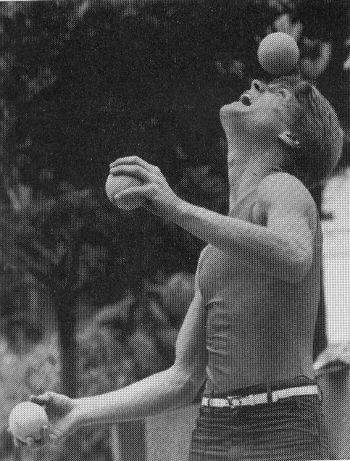
Mark Nizer plays San Diego's Balboa Park (photo courtesy M. Nizer) |
Page 15 Summer 1990
|
Probably
the most successful of the groups, and the one that has remained
most loyal to its roots, is The Flying Karamazov Brothers. Their
theatrical presentation of comedy, juggling and music was born in
the streets of
Karamazov
Brother Tim Furst
says their current show in every way reflects its street heritage,
"the fact that we don't work with a director, the
improvisation, bantering back and forth with the audience, not being
afraid to drop things or try different things, and the general
energy level. If you do street a lot, it means you can do some
things in your sleep. You can improvise around them and don't have
to concentrate on the actual juggling,"
As
these early street performers have moved onto more legitimate
stages, the street scene has faded away. You don't find jugglers at
the
Mark
Nizer, for one, regrets this institutionalizing of the street scene.
"The purist thrives for the no-control environment," he
said. 'We've lost the places where people can develop their acts and
form their performing personalities."
Nelson
fears the era of free-spirited street performing is over, its brief
flame consumed and institutionalized in a way that will prevent a
younger generation from enjoying opportunities for growth that were
available a decade ago. "Especially since the earthquake last
fall it's the end of an era in street performing out here it
seems," he said. "A lot of people are not coming to
Nevertheless,
the increased exposure of juggling in the 20 years since those business around sales of "Juggling For the Complete Klutz," a book with three bean bags attached that has found its way into hundreds of thousands of homes.
The
kids who started on the street began a process that has removed
juggling from the exclusive domain of the circus and nightclub and
turned it into an approachable endeavor for everyone. The street
performer was physically close to the audience instead of separated
from them by the "fourth wall" of a stage. Instead of being
quiet during the performance, he invited and encouraged their banter
and jokes. And instead of disappearing into a dressing room after the
show he sat around to talk with them and teach them to juggle.
The
domino effect took hold as new jugglers showed their friends how easy
it was to learn the three-ball cascade. Those who learned and stuck
with it to try the reverse cascade. shower, behind-the-back throws,
more balls, clubs, devil sticks, cigar boxes and diabolos began
gathering in
Juggling
became increasingly popular as an adult hobby and became in many
schools a basic part of the physical education curriculum. The growth
of the movement fueled substantial growth in the IJA. Annual
conventions began swelling in 1975. and recent ones, including the
1986 convention in
Wherever the annual festival goes, it attracts attention and enthusiasm. But this year's festival at UCLA will surely have a bit more meaning for some of the stars on stage as they think back 20 years to their radical beginnings as a street performer in Westwood,just a few blocks away. |

Mark Nizer plays San Diego's Balboa Park (photo courtesy M. Nizer) |